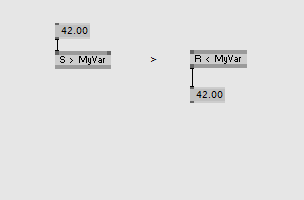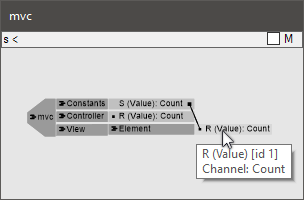Send-Receive

Data can be sent from one part of a patch to another (or between patches) using the S (=send) and R (=receive) nodes without making a direct link between pins.
The most common use case for S/R nodes is to deliver global constants/variables from a central patch to different parts of a project.
Creating an S node can be compared to assigning a variable. A corresponding R node lists all available variables on its Receive String and by selecting one of those, it returns the corresponding value.
Technically there is no difference between creating a link between two pins or using an S/R combo to pass data.
Creating via Shortcut
The quickest way to create an S or R node is starting a link from a pin and then pressing CTRL+Middleclick. An S node created this way also automatically has its Send String set to the connected outputs name.
Advanced
The addonpack comes with an alternative version of the nodes labeled "Advanced" provided by vux. The differences are:
- Receive String is of type string (instead: Enumeration)
- the same send string can be used on multiple S nodes in which case matching R nodes work in LTP (last takes precedence)
- attention: for technical reasons the nodes may (or may not) introduce a one frame delay
Lost your S/R nodes?

If you've got lost where all the S and R nodes are buried in your project, the Finder is your friend.
Open the Finder CTRLF and type 's <'. It will show you a relation of all the subpatches that contain S and R nodes. Hovering the mouse over any of them shows their connection(s).
